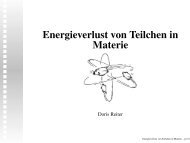The FEE Server Control Engine of the ALICE-TRD - Westfälische ...
The FEE Server Control Engine of the ALICE-TRD - Westfälische ...
The FEE Server Control Engine of the ALICE-TRD - Westfälische ...
You also want an ePaper? Increase the reach of your titles
YUMPU automatically turns print PDFs into web optimized ePapers that Google loves.
Average pulse height (mV)<br />
4 <strong>The</strong> <strong>ALICE</strong> Transition Radiation Detector<br />
120<br />
100<br />
80<br />
60<br />
40<br />
20<br />
0<br />
e dE/dx+TR<br />
e dE/dx<br />
π dE/dx<br />
p=2 GeV/c<br />
0 0.5 1 1.5 2 2.5 3<br />
Drift time (μs)<br />
Figure 4.4: Average pulse height as a function <strong>of</strong> drift time for pions and electrons with a momentum<br />
<strong>of</strong> 2 GeV/c (with and without transition radiation) (image taken from [And04]).<br />
induce a measurable image charge on <strong>the</strong> cathode pads. This charge is read out by <strong>the</strong><br />
front end read out electronics every 100 ns.<br />
Figure 4.4 shows <strong>the</strong> time evolution <strong>of</strong> <strong>the</strong> signal for different particles. One can divide<br />
<strong>the</strong> signal in four sections. <strong>The</strong> first three points are recorded before <strong>the</strong> particle crosses<br />
<strong>the</strong> chamber. <strong>The</strong>n <strong>the</strong> particle flies through <strong>the</strong> chamber and liberates electrons along<br />
its path. First <strong>the</strong> electrons liberated in <strong>the</strong> amplification region reach <strong>the</strong> anode wires.<br />
Since electrons from both sides <strong>of</strong> <strong>the</strong> anode wire plane reach <strong>the</strong> wires <strong>the</strong> number <strong>of</strong><br />
avalanches and <strong>the</strong>refore <strong>the</strong> number <strong>of</strong> created ions is high. This results in a sharp<br />
increase <strong>of</strong> <strong>the</strong> signal. A few time bins later <strong>the</strong> electrons liberated in <strong>the</strong> amplification<br />
region all have reached <strong>the</strong> anode wires. Now <strong>the</strong> first electrons liberated in <strong>the</strong> drift<br />
region near <strong>the</strong> cathode wires reach <strong>the</strong> anode plane. Since no electrons reach <strong>the</strong> anode<br />
plane from <strong>the</strong> pad plane side anymore, <strong>the</strong> number <strong>of</strong> avalances decreases. This leads to<br />
a decreasing signal. In case <strong>of</strong> electrons, at <strong>the</strong> end <strong>of</strong> <strong>the</strong> drift time additional electrons<br />
liberated by <strong>the</strong> transition radiation reach <strong>the</strong> anode plane. <strong>The</strong> number <strong>of</strong> avalanches<br />
and <strong>the</strong>refore <strong>the</strong> number <strong>of</strong> created ions increases again and leads to a rising signal.<br />
4.2 Infrastructure Services<br />
A supermodule needs for operation four infrastructure services: low voltage and cooling<br />
for <strong>the</strong> front end readout electronics and high voltage and <strong>the</strong> correct gas mixture for <strong>the</strong><br />
drift and amplification region <strong>of</strong> <strong>the</strong> chamber.<br />
27







